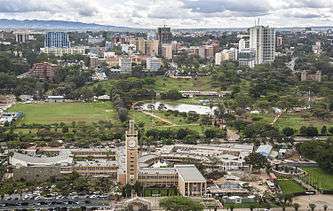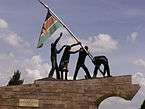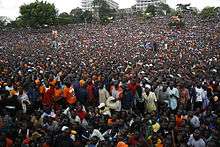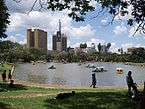Uhuru Park

Uhuru Park is a 12.9 hectare recreational park adjacent to the central business district of Nairobi, Kenya. It was opened to the general public by the late Mzee Jomo Kenyatta on 23 May 1969. It contains an artificial lake, several national monuments, and an assembly ground which has become a popular skateboarding spot on weekends, catering to Nairobi's growing skate scene.
Apart from skateboarding, the assembly ground is used for occasional political and religious gatherings. It is infamous as the site where protest against illegal land grabbing was violently broken up by the Moi regime.
In 1989, Wangari Maathai and many of her followers held a protest at the park, attempting to stop the construction of the 60-storey Kenya Times Media Trust business complex. She was forced by the government to vacate her office and was vilified in parliament, but her protests and the government's response led foreign investors to cancel the project.[1]
In August 1996, a group led by a Catholic cardinal and Archbishop Maurice Michael Otunga burned a heap of condoms in Uhuru Park.[2]
Uhuru Park was the scene of a bomb blast in June 2010, which killed six people and left over 100 people injured. The attack targeted a "NO" campaign rally for the forthcoming constitutional referendum.[3]
Gallery
 National Monument
National Monument Nyayo Monument
Nyayo Monument Nairobi skyline from the park
Nairobi skyline from the park
 Lake
Lake Fountain
Fountain
References
| Wikimedia Commons has media related to Uhuru Park. |
- ↑ The Ecologist (2001). The Good, the Bad, and the Ugly. Retrieved 2009-04-10.
- ↑ International Freedom of Expression Exchange
- ↑ Afrique en ligne, June 14, 2010: Kenya: Death toll from Kenya bomb attacks rises